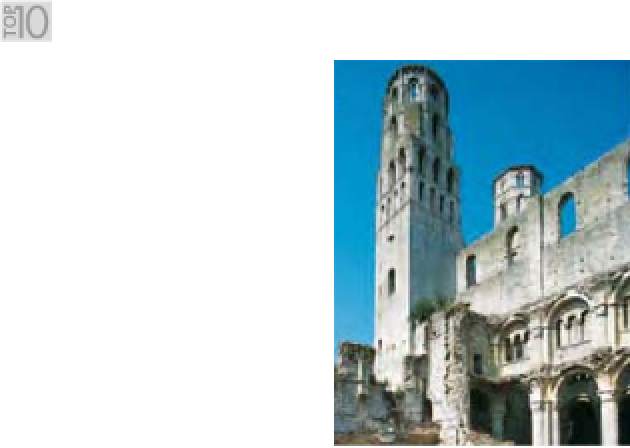Travel Reference
In-Depth Information
Left
Mont-St-Michel
Right
Abbaye-aux-Hommes, Caen
Norman Abbeys
Mont-St-Michel
Dramatically sited on a lone
rock in the Bay of Mont-St-
Michel, this famous abbey exerts
a huge draw on the thousands
who visit every year
(see pp8-11)
.
Jumièges
A centre of learning for 700
years, Jumièges became nothing
more than a quarry after the
Revolution. Today, its enigmatic
ruins, romantically set in a loop
of the Seine, live again as one of
the “must-see” sights of
Normandy
(see pp18-19)
.
Abbaye de Jumièges
Le Bec-Hellouin
In 1034, a knight called
Herluin exchanged his charger
for a donkey and founded a
religious community on the
banks of the River Risle. When
he was joined some eight years
later by the influential Italian
theologians Lanfranc and
Anselm, the monastery grew to
become the intellectual heart of
Normandy. Disbanded in the
Revolution and later demolished,
it again became a Benedictine
monastery in 1948
(see pp89, 92)
.
Abbaye-aux-Dames, Caen
Like their founders William
and Matilda, the Abbaye-aux-
Hommes and Abbaye-aux-Dames
(the first of the two to be built) are
close cousins
(see p24)
. The lovely
convent buildings were designed
by Guillaume de la Tremblaye.
St-Georges, St-Martin-de-
Boscherville
In 1114, William of Tancarville
founded a small community of
monks, who took this beautiful
Norman Romanesque building as
their abbey church (
see p80)
.
Abbaye-aux-Hommes,
Caen
Lanfranc was the first abbot of
the abbey, which was founded
by William the Conqueror and
consecrated in his presence in
1077. Ten years later, William was
buried, most unceremoniously, in
the abbey's church, St-Etienne
(see p24)
.
St-Wandrille
Founded in 649 and rebuilt in
the 10th century after destruction
by Norsemen, the abbey became
a centre of learning. Inevitably, the
Revolution saw its demise, but in
1931 it once again became a
Benedictine monastery
(see p80)
.
For more on William the Conqueror
See p15
46














